
Hibbertia stellaris, commonly known as star guinea flower or orange stars, is a brilliantly orange flowering ground cover from the South Western Australian botanical province. It naturally grows in swamps; despite this, it is extremely sensitive to phytophthora and needs to be grown in well-drained soil in cultivation.

Gompholobium huegelii, commonly known as common wedge-pea is a species of flowering plant in the family Fabaceae and is endemic to south-eastern Australia. It is an erect or spreading shrub with trifoliate leaves and cream-coloured to yellow and greenish, pea-like flowers.

Darwinia vestita, commonly known as pom-pom darwinia, is a species of flowering plant in the family Myrtaceae and is endemic to the southwest of Western Australia. It is an erect, bushy shrub with crowded egg-shaped, oblong, or linear leaves and more or less spherical heads of white to reddish-pink flowers.

Boronia cymosa, commonly known as granite boronia, is a plant in the citrus family Rutaceae and is endemic to the south-west of Western Australia. It is an erect shrub with linear, more or less cylindrical leaves and groups of relatively small, pink four-petalled flowers arranged on branched flowering stems.

Boronia falcifolia, commonly known as the wallum boronia, is a plant in the citrus family, Rutaceae and is endemic to near-coastal areas of eastern Australia. It is a shrub with only a few stems, usually three-part leaves and bright pink, four-petalled flowers.
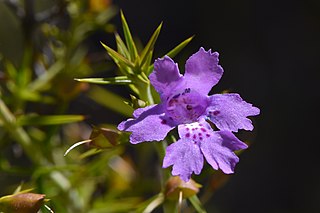
Hemiandra linearis, commonly known as speckled snakebush, is a species of prostrate to ascending shrub that is endemic to the south-west of Western Australia.

Comesperma integerrimum is a twining shrub or climber in the family Polygalaceae.

Goodenia pulchella is a species of flowering plant in the family Goodeniaceae and is endemic to the south-west of Western Australia. It is an erect to ascending herb with lance-shaped leaves mostly at the base of the plant, and racemes of yellow flowers.
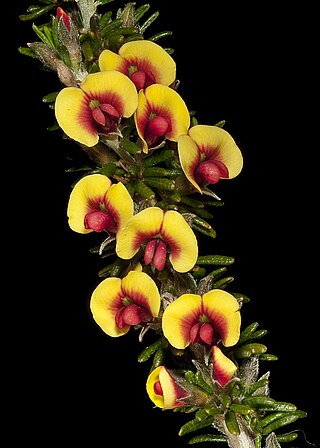
Mirbelia spinosa is a species of flowering plant in the family Fabaceae and is endemic to the south-west of Western Australia. It is a spiny shrub with narrowly linear leaves and yellow, orange and reddish-brown flowers.

Lechenaultia floribunda, commonly known as free-flowering leschenaultia, is a species of flowering plant in the family Goodeniaceae and is endemic to the south-west of Western Australia. It is an openly-branched shrub or subshrub with crowded, narrow, fleshy leaves and compact groups of pale blue to pale mauve or creamy white flowers.
Lasiopetalum cordifolium, is a species of flowering plant in the family Malvaceae and is endemic to the south-west of Western Australia. It is an erect shrub with hairy stems, heart-shaped leaves and pink, cream-coloured or white flowers.

Sphaerolobium alatum is a species of flowering plant in the family Fabaceae and is endemic to the south of Western Australia. It is a slender, leafless shrub with yellow and reddish-brown flowers from September to November.
Sphaerolobium fornicatum is a species of flowering plant in the family Fabaceae and is endemic to the far south-west of Western Australia. It is a leafless shrub that typically grows to a height of 0.1–1 m and has yellow or orange and red flowers from October to January.

Sphaerolobium grandiflorum is a species of flowering plant in the family Fabaceae and is endemic to the south of Western Australia. It is an erect, slender, leafless shrub with red, yellow and orange flowers.

Sphaerolobium linophyllum is a species of flowering plant in the family Fabaceae and is endemic to the south of Western Australia. It is a prostrate to ascending shrub with a few narrowly linear leaves and red, yellow and orange flowers.
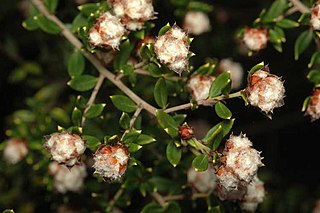
Spyridium buxifolium is a species of flowering plant in the family Rhamnaceae and is endemic to New South Wales. It is a spreading shrub with egg-shaped to elliptic leaves, and heads of white, softly-hairy flowers with brown bracts at the base of the heads.
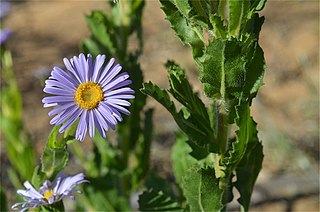
Olearia rudis, commonly known as azure daisy-bush, is a species of flowering plant in the family Asteraceae and is endemic to eastern Australia. It is a usually short-lived shrub with crowded elliptic or egg-shaped leaves, and pale blue, mauve or purple and orange, daisy-like inflorescences.
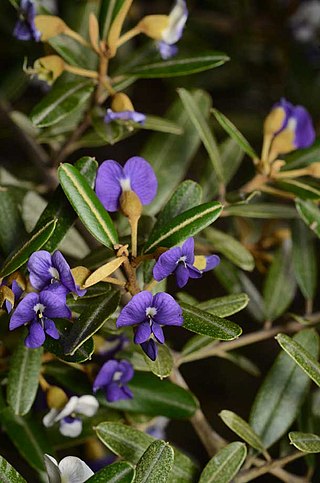
Hovea longipes is a species of flowering plant in the family Fabaceae and is endemic to north-eastern Australia. It is a shrub or tree with narrowly elliptic to lance-shaped leaves, and deep indigo-blue and white, pea-like flowers.

Spyridium spadiceum is a species of flowering plant in the family Rhamnaceae and is endemic to the south of Western Australia. It is an erect or semi-prostrate shrub with narrowly oblong to oval leaves and heads of hairy flowers with brown bracts at the base.
Commersonia parviflora, commonly known as small flowered rulingia, is a species of flowering plant in the family Malvaceae and is endemic to the south of Western Australia. It is a low, prostrate or dense shrub with wrinkled, egg-shaped leaves with rounded teeth on the edges, and clusters of small, white flowers.

















